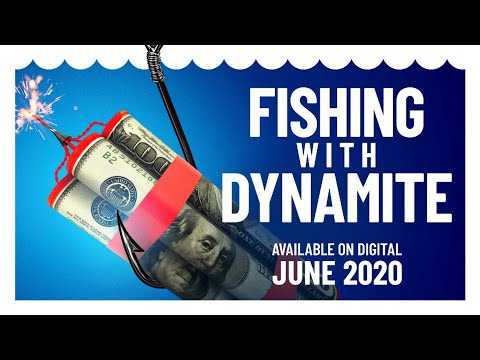“How selfish soever man may be supposed, there are evidently some principles in his nature, which interest him in the fortune of others, and render their happiness necessary to him, though he derives nothing from it except the pleasure of seeing it.”
-Adam Smith, The Theory of Moral Sentiments (1759)
In 2019, Fishing With Dynamite, a documentary by filmmaker Paul Wagner outlining the deteriorating faith in the American economic system was released to, let’s call it, meager praise. The title of the film, Fishing With Dynamite, serves as a metaphor to represent the reckless and destructive methods many corporations employ in order to earn profits. These methods are often “quick-fix” or “near-sighted” approaches that extract profits quickly, though leave behind pollution that will negatively impact the corporation and all its constituents in the future.

This article will, in part, attempt to construct meaning out of Fishing With Dynamite (which deserves a much wider viewership), which posits questions that lie at the core of American Capitalism. For instance, what is a shareholder? For what reasons are they valued above all others when conducting business? And perhaps most importantly, what is a stakeholder, and how is the growing trend towards a stakeholder-driven economy going to affect American capitalism in the long-term?
The Shareholder Theory
The shareholder theory can be defined as “the approach of American business to center their decisions, values, and goals to the aim of one target: maximizing the profits of the company’s shareholders.”
Before we move on, let’s define the terms shareholder and stakeholder.
A shareholder “owns part of a public company through shares of stock” and a stakeholder is someone with a vested interest in a company such as employees, customers, suppliers, communities, governments, and yes, shareholders. –Investopedia
With that cleared up, let’s continue…
Most graduate business students today, as the film notes, emerge from university with the belief that the purpose of a business is to maximize profits for its shareholders. Sometimes this can, unfortunately, mean “by all means necessary.”
The film highlights this and references their reckless approach to business in the title, Fishing With Dynamite, a metaphor for a destructive and often illegal method of using explosives to harvest large amounts of fish without regard for the surrounding aquatic ecosystem.

The shareholder theory itself was first proposed by Michael Jensen, an American economist who in 1976 wrote what might be known as the manifesto of shareholder-driven decision making: Theory of the Firm: Managerial Behavior, Agency Costs, and Ownership Structure. This paper set the standard for how CEOs of businesses on Wall Street would subsequently conduct their strategizing and profit maximization.

Coincidentally enough, Michael Jensen today regards the shareholder theory as a misinterpretation of what he was trying to say and calls it a “stupid idea.”
Along with “Reaganomics,” (or “free-market economics,” “supply-side economics,” “trickle-down economics,” and “voodoo economics,” which confusingly, refer to the same thing) the shareholder theory took complete hold of the economy in the 1980s. Further implementations, such as stock options (“the right to buy company stock, in the future, at today’s price”) and corporate buybacks (“when the CEO of a company reduces the total number of shares on the market, so the value of each individual share goes up”) reinforced the notion that the American economy is driven by shareholder value.
This theory is in part derived from the idea that the shareholders are the true owners of a business. However, this is one of the great myths of the American economy that many people believed. As Lynn Stout, Professor at Cornell Law School states in Fishing With Dynamite, “What shareholders own, is shares of stock. And a share of stock is a kind of contract between the human being who owns the stock and the corporate entity.” Therefore, the owner of the stock, just one of many stakeholders, has in no part more ownership over the corporate entity than any other stakeholders.
Problems with the Shareholder Theory
You may now ask, what is the problem with the shareholder theory; Certainly, people who risk certain investments in a company deserve to be rewarded for their risks? Yes, but no, what the shareholder theory prioritizes at its utmost is increasing the profits of the shareholder, therefore increasing the profits of the stock, and in turn, the corporate entity.
So, what happens to the rest of the stakeholders involved in the success of the business, and where and when are they compensated for their service to the company? Many times they are not. They are taken for granted for the work that they put into the company, while the shareholders and CEO, given that the stock of the company has risen, are rewarded for their efforts.
This isn’t to say earning profits for a business is not important–it certainly is. Although, shareholders should neither be the first, nor primary concern. In fact, increasing shareholder value should be a byproduct of creating value for the other stakeholders aforementioned.
A company should be profitable in other ways, which can be done by creating value for employees by providing reasonable salaries, benefits, and growth opportunities within the business. This leads to a happier, more efficient workforce that in turn affects how customers interact with the business.
A valued staff will ordinarily go the extra mile for a customer, both out of respect for their job and for the business, leading to a strong base of customers and in turn more creditors and investors. Conducted with the interests of the community at large, this business will be able to foster a symbiotic relationship, whereby the community provides a dedicated workforce and customer base, and the business provides jobs, benefits, and opportunities to share in the wealth of the business.
Be better to your stakeholders…
Today, there are many entrepreneurs who are sensitive to the pitfalls of a shareholder-driven business model and instead opt for the stakeholder method: to “maximize the value of all stakeholders — not simply money or products, but value.” (Reminder: a stakeholder represents anybody that has a stake in the success of a business, i.e., employees, customers, suppliers, shareholders, creditors, communities, and the nation at large).


If a business is run to satisfy all of these people equally, then it will likely be defined as a stakeholder-driven business. Fishing With Dynamite highlights companies today like Whole Foods, Costco, and The Container Store as operating under this model with great success. It also gives special mention to The Hewlett-Packard Company, commonly known as HP, which has successfully been run using the stakeholder method since the 1930s.
Eco-Stylist, an online marketplace for stylish and sustainable brands, certifies brands that, like the businesses above, are stakeholder-driven. Brands like Patagonia, Outerknown, Adelante Shoe Co., Nudie Jeans, and Known Supply are all examples.

You can tell these brands are stakeholder-driven businesses because they do things like pay their workers living wages, give back to the communities they operate in, reduce the environmental impact of their business, let you meet the person who made the product you purchased, and more.
As Jim Sinegal, CEO of Costco, notes in the documentary, “Wall Street is in the business of trying to make money between now and next Tuesday. We’re trying to build an institution and organization that will be around sixty years from now.” The way to do that, as the CEOs of stakeholder-driven companies imply, is to create a business where every variable is acknowledged and valued. Evidence shows that over the long term, your business will do better and your shareholders will do better if you’re sensitive to your employees, environment, community, and other stakeholders.
Stakeholder-driven companies call attention to all the good things a business in a capitalist system can be. They have a primary purpose and a goal, which in the case of a company like Whole Foods, for example, would be to “nourish people and the planet” by providing quality, organic food, supplied in an ethical and sustainable manner for the benefit of the planet and people. This purpose is shared among its constituents who derive satisfaction and meaning from the work they do, because they know that they are valued and that they are providing value to others.
On the other hand, in a shareholder-driven business this idea of purpose and unity seems to untangle and fall to pieces on the floors of the stock exchange, where everyday it can be seen where the true purpose of that corporation lies, i.e. not in the value of its stakeholders, but in the motivations to make money and to make it fast.
So, why does this all matter?
Considering the widening gap in wealth in America and the rising number of Americans finding dissatisfaction with their jobs, the stakeholder model seems to become an increasingly more reliable strategy to tackle these issues. While there will always be gaps in wealth in a Capitalist system, perhaps with a strategy that centers on providing value and profits for all of the constituents of an enterprise, we can help narrow the gaps. We can do this by focusing our attention away from only pleasing shareholders and/or CEO’s who benefit heavily from a rise in stock prices.

Another outcome of this model is that it could help to reinvigorate the confidence and belief in a Capitalist system that today is waning. To an extent, this mistrust can be validated, as the American Capitalist system is often criticized for its abilities to increase gaps in wealth (both acutely and in the long term), for creating massive economical inequality, and for its exploitation of labor. All three of which are not new problems that America faces, but ones it has wrestled with since the 19th century.
However, it isn’t unreasonable to assume that this can change and that in certain sectors, it has. Many startups today, fueled by the desire to create a product or service that benefits all of their stakeholders, are an inherently benevolent aspect of the capitalist system. These startups have all the means and possibilities in which to create good in America and beyond, just as they have all the means to create a greed-driven system that exploits labor, divides communities, and unfairly benefits the rich.
Whether you approach it from a conservative or liberal point-of-view, the fact of the matter is that capitalism, in its essence, is neither good nor bad, it is indifferent. It is a system of exchange that, done properly and with care, can be a benefit to all.
Now, what do we do about it?
So, let’s ponder this: A stakeholder-driven model will work. So, how do we get there? Let’s start with the big structural changes and end with the things you can do (the good stuff).

When it comes to bigger, structural changes, Fishing With Dynamite posits some real valuable ideas for solutions:
- The government can change the law by tying CEO pay to share price (For many years now CEO compensation has come largely from things like stock options, where an executive buys large amounts of stock at a “fixed price” for a certain amount of time, often 3-5 years. This can influence shareholders to buy more stock, but what it also can do is shift focus to short-term gains, where the CEO is rewarded with large profits and long-term investors are not) and it can lower taxes on long-term stock investments.
- Companies can pay higher dividends (Company profits distributed quarterly to shareholders. Shareholders are given the right to vote on corporate actions and are often granted one vote per share. Unfortunately, short-term investors with large shares may use this power to increase short-term gains that can hinder the longevity of the company) to long-term investors and limit the voting power of short-term shareholders.
- Companies can focus quarterly calls (calls made by the CEO, which highlight the companies earnings over the past quarter. Unfortunately, the reporting of these earnings largely influences the value of the company) on the long-term, not the short term. And in general, can operate in a way that serves all their stakeholders.
Now, for the good stuff. Here’s what you can do today:
- We can all buy from and invest in responsible companies. Check out our certified sustainable brands as well as the B Corp directory to get started.
- Watch Fishing with Dynamite and share it with friends and family on social media.
- Share this article! Good ideas only spread when they’re… well, spread. Share the love.



That first one really rings a bell, for if we want to change the way we do business, we must change who we decide to do business with. Invest your dollars into companies that care about their workers, about you–the customer, about their community, about their suppliers, creditors, the environment, and the world at large.
It’s a seemingly simple, albeit monumental step where we can change the outcome of the future by doing what is right. For as Adam Smith notes (in the quote at the top), there are things in our nature that interest us in the fortune of others, and their happiness is our happiness. Good business has the potential to serve all stakeholders.

Ryan Nielsen is a writer at Eco-Stylist. He recently graduated from the University of Iowa with degrees in Cinema and English and Creative Writing. He plans to further his passion for cinema by working in film and television, writing screenplays.










